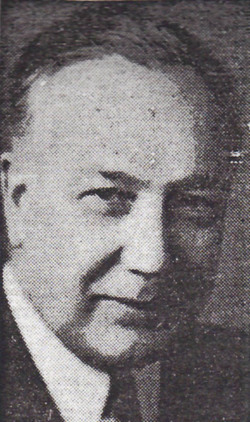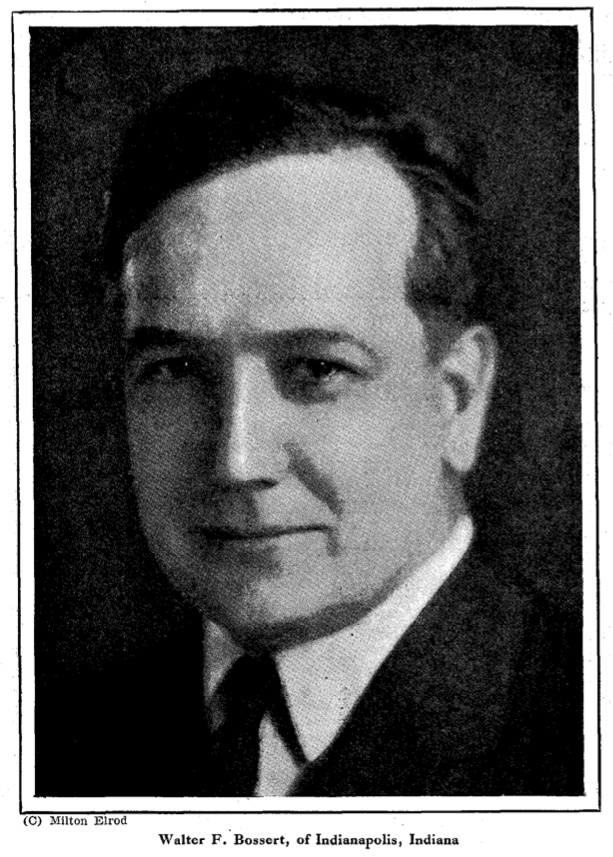Bossert was born and attended grade and high schools in Brookville, Indiana. He obtained a law degree from Indiana University in 1907. He practiced law in Brookville for two years and was appointed deputy prosecutor for Franklin, Union, and Fayette counties when they constituted a judicial district. He then practiced law in Terre Haute for two years before resettling to Liberty in 1912. Continuing his legal practice, he was also attorney for the City of Liberty and for Union county. In 1923 Bossert and his brother Elmer, also a Klansman, formed the firm Bossert and Bossert, where he continued to work until ill health forced his retirement in 1944. From 1922 to 1926 he also maintained a law office in Indianapolis. He led the effort to have the votes of 600 Catholic sisters at a Convent in Oldenburg, Indiana tossed out because he believed they had no legal right to vote.
Bossert was chairman of the Union County Republican Committee from 1910 to 1914, and was chairman of the sixth ("Old Burnt") district, from 1916 to 1922. He served on the Republican state committee. Bossert assisted national Republican Party chairman and morality crusader Will H. Hayes and often travelled with Hayes around the country.
He was president of the General Implement Company and treasurer of the Duplex Steel Reinforcement Company. He and his brother also farmed in Union and Marion counties.
Indiana had more KKK members than any other state during the 1920s, and the Klan controlled the governorship, the state legislature, and many local governments. D.C. Stephenson engineered the Klan's rise to power in Indiana, but due to factional conflicts Stephenson was ousted and eventually replaced by Bossert, who had been put in charge of the Klan's national propagation headquarters in Indianapolis. Bossert was designated G-1 National and Imperial Klaliff, making him the second most powerful Klan member in the country after Imperial Wizard Hiram Evans.
(http://books.google.com/books?id=uQsGM72GVFkC&pg=PA51&lpg=PA51&dq=walter+bossert+klan&source
=bl&ots=b0U4L5L0cp&sig=Od1zW7YarRyfVhIamkuWJF0z6Ws&hl=en&ei=VHF
JSqfrM43cNeK9zfwG&sa=X&oi=book_result&ct=result&resnum=20)
Stephenson failed in his attempt to regain control and end what he called the "supine obedience of klansmen to orders from South of the Mason and Dixon line." The Klan's Imperial headquarters was then in Atlanta. In 1925, when Stephenson was convicted of the murder of a woman he allegedly violently raped, the Klan quickly fell out of favor and lost political influence. This decline marked Bossert's last year as Grand Dragon. According to Klan insiders, Bossert was forced to resign as Grand Dragon because he was not supportive of the reelection of Republican U.S. Senator James E. Watson. He was replaced by W. Lee Smith, of Evansville. (Smith's tenure was short. In 1927 he infuriated Klan members by taking a Catholic wife, and In 1928 he was imprisoned for his role in a car theft ring.)
(http://news.google.com/newspapers?nid=950&dat=19261027&id=mewLAAAAIBAJ&sjid=1VQDAAAAIBAJ&pg=1876,185523)
Bossert remained active in Republican politics, unsuccessfully seeking the party's nomination for U.S. senator at the 1938 state convention. He tried again in 1940, but his name was not placed in nomination at that year's convention.
In 1943 he was named board chairman of the Indiana Old Age Pension Fund.
Bossert was reportedly a member of the Scottish Rite (32nd degree Mason), Knights of Pythias (Violet Chapter), and the Order of the Eastern Star. He held the post of president of the Methodist Brotherhood of Liberty. His funeral service was conducted at the Fosdick Funeral Home, with O. E. Parrett, pastor of Edwards Memorial Methodist Church presiding and Rev. John H. Carnes, pastor of Central Methodist Church in nearby Richmond assisting. The joint Union and Franklin county circuit courts adjourned for a day out of respect for the former Klan leader.
Bossert was the son of Abraham (Longnecker, Ohio) and Carrie Krueger Bossert (Cincinnati, Ohio). Abraham was a merchant in Brookville. According to one record, Walter Bossert was married to Healen Margaret Roach on August 21, 1913.
See: "Walter Gets The Money," The Post Democrat, Muncie, Indiana, Sept. 19, 1924, pg. 1.
Excerpt:
"The frequently heard assertion that 'klan leaders will do any-thing for money,' is certainly exemplified to the nth degree in the case of Walter Bossert. This debased scoundrel, who boldly declares himself the brigadier heading a treasonable army of vagrants who seek to overthrow the government of the United States and the state of Indiana, shows his unspeakably vile nature by sponsoring the sale of literature which places the brand of the Magdalen on the women of the church to which his own wife and wife's mother belong."
http://libx.bsu.edu/cgi-bin/showfile.exe?CISOROOT=/PostDemNews&CISOPTR=130&filename=131.pdf
Bossert had four sisters: Adelia Anna Blome; Mable Bossert; Pauline Caroline Bossert; Edna Marie Bossert.
Bossert was born and attended grade and high schools in Brookville, Indiana. He obtained a law degree from Indiana University in 1907. He practiced law in Brookville for two years and was appointed deputy prosecutor for Franklin, Union, and Fayette counties when they constituted a judicial district. He then practiced law in Terre Haute for two years before resettling to Liberty in 1912. Continuing his legal practice, he was also attorney for the City of Liberty and for Union county. In 1923 Bossert and his brother Elmer, also a Klansman, formed the firm Bossert and Bossert, where he continued to work until ill health forced his retirement in 1944. From 1922 to 1926 he also maintained a law office in Indianapolis. He led the effort to have the votes of 600 Catholic sisters at a Convent in Oldenburg, Indiana tossed out because he believed they had no legal right to vote.
Bossert was chairman of the Union County Republican Committee from 1910 to 1914, and was chairman of the sixth ("Old Burnt") district, from 1916 to 1922. He served on the Republican state committee. Bossert assisted national Republican Party chairman and morality crusader Will H. Hayes and often travelled with Hayes around the country.
He was president of the General Implement Company and treasurer of the Duplex Steel Reinforcement Company. He and his brother also farmed in Union and Marion counties.
Indiana had more KKK members than any other state during the 1920s, and the Klan controlled the governorship, the state legislature, and many local governments. D.C. Stephenson engineered the Klan's rise to power in Indiana, but due to factional conflicts Stephenson was ousted and eventually replaced by Bossert, who had been put in charge of the Klan's national propagation headquarters in Indianapolis. Bossert was designated G-1 National and Imperial Klaliff, making him the second most powerful Klan member in the country after Imperial Wizard Hiram Evans.
(http://books.google.com/books?id=uQsGM72GVFkC&pg=PA51&lpg=PA51&dq=walter+bossert+klan&source
=bl&ots=b0U4L5L0cp&sig=Od1zW7YarRyfVhIamkuWJF0z6Ws&hl=en&ei=VHF
JSqfrM43cNeK9zfwG&sa=X&oi=book_result&ct=result&resnum=20)
Stephenson failed in his attempt to regain control and end what he called the "supine obedience of klansmen to orders from South of the Mason and Dixon line." The Klan's Imperial headquarters was then in Atlanta. In 1925, when Stephenson was convicted of the murder of a woman he allegedly violently raped, the Klan quickly fell out of favor and lost political influence. This decline marked Bossert's last year as Grand Dragon. According to Klan insiders, Bossert was forced to resign as Grand Dragon because he was not supportive of the reelection of Republican U.S. Senator James E. Watson. He was replaced by W. Lee Smith, of Evansville. (Smith's tenure was short. In 1927 he infuriated Klan members by taking a Catholic wife, and In 1928 he was imprisoned for his role in a car theft ring.)
(http://news.google.com/newspapers?nid=950&dat=19261027&id=mewLAAAAIBAJ&sjid=1VQDAAAAIBAJ&pg=1876,185523)
Bossert remained active in Republican politics, unsuccessfully seeking the party's nomination for U.S. senator at the 1938 state convention. He tried again in 1940, but his name was not placed in nomination at that year's convention.
In 1943 he was named board chairman of the Indiana Old Age Pension Fund.
Bossert was reportedly a member of the Scottish Rite (32nd degree Mason), Knights of Pythias (Violet Chapter), and the Order of the Eastern Star. He held the post of president of the Methodist Brotherhood of Liberty. His funeral service was conducted at the Fosdick Funeral Home, with O. E. Parrett, pastor of Edwards Memorial Methodist Church presiding and Rev. John H. Carnes, pastor of Central Methodist Church in nearby Richmond assisting. The joint Union and Franklin county circuit courts adjourned for a day out of respect for the former Klan leader.
Bossert was the son of Abraham (Longnecker, Ohio) and Carrie Krueger Bossert (Cincinnati, Ohio). Abraham was a merchant in Brookville. According to one record, Walter Bossert was married to Healen Margaret Roach on August 21, 1913.
See: "Walter Gets The Money," The Post Democrat, Muncie, Indiana, Sept. 19, 1924, pg. 1.
Excerpt:
"The frequently heard assertion that 'klan leaders will do any-thing for money,' is certainly exemplified to the nth degree in the case of Walter Bossert. This debased scoundrel, who boldly declares himself the brigadier heading a treasonable army of vagrants who seek to overthrow the government of the United States and the state of Indiana, shows his unspeakably vile nature by sponsoring the sale of literature which places the brand of the Magdalen on the women of the church to which his own wife and wife's mother belong."
http://libx.bsu.edu/cgi-bin/showfile.exe?CISOROOT=/PostDemNews&CISOPTR=130&filename=131.pdf
Bossert had four sisters: Adelia Anna Blome; Mable Bossert; Pauline Caroline Bossert; Edna Marie Bossert.
Family Members
Sponsored by Ancestry
Advertisement
Advertisement




















